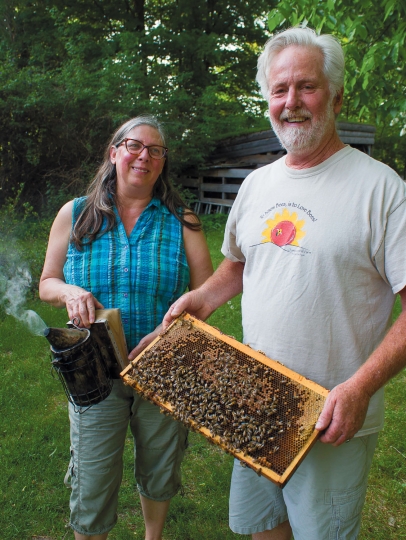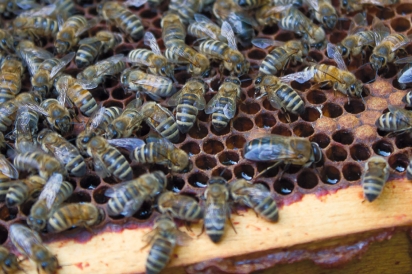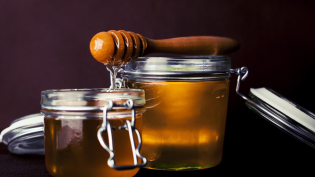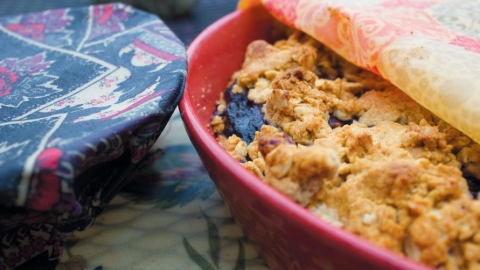Sweet Harvest
When I was a little girl and my father was cooking, my brother and I would ask him what we were having for dinner and he would say, with great enthusiasm, “Bee’s knees!” and laugh and laugh. My childish imagination could not begin to picture what a meal of skinny little parts of bees would consist of!
That rhyming colloquialism became popular in the 1920s and is based in fact, as I learned during the summer evening I spent at Champion Hill Farm. Bees actually do use little sacs on their knees to bring pollen back to the hive. It’s not just some weird thing my father used to say! Whatever vegetables or fruit might have been on that meal’s menu, it’s likely that a bee and its knee sacs played a role in pollinating it.
Champion Hill Farm is the home of and headquarters of an intensive beekeeping operation run by husband-and-wife team Greg Griswold and Therese Povolo. Greg started learning beekeeping back in the early 1980s when he was working three jobs to support himself. One of those jobs was assisting a beekeeper, who gave Greg a hive at the end of the season. He enjoyed the process so much that he started building up the number of hives he had. He and Therese now have a thriving business selling honey and honey products in Northern Michigan. He does most of the work directly with the bees and Therese runs the bottling and packaging part of the business.
We spoke about bees and their honey. Here are some excerpts.
Edible Grande Traverse: How did you come to start your honey business?
Greg Griswold: When I lost my job in 2008, I decided to launch Champion Hill Farm. I collaborated with my wife, Therese, and she had the great idea to partner with the local organic farmers who do CSAs, putting hives on those farms. That has really been a big part of the success of our business, because the customers of those farms have become our customers, and they have become a pretty good loyal following.
Therese Povolo: On one of our first dates, back in 1987, he said to me, “I have to go move some hives.” And moving hives has to be done at night, like 11 o’clock, when the bees are quiet and sleeping in the summertime. We were in this old pickup truck, and here I am out in the wild with my new love interest, and the truck broke down, and we had all these hives on the back of the truck. Greg knew he needed a can, and he had a can, and he knew what to do, so I held the flashlight and he fixed the truck right there, and I thought, “Wow, this guy is pretty talented!” So I started helping him with the harvest, and he kept getting more bees, and we sold honey in bulk. But in 2009 we created the label and started bottling the honey, and started selling products for retail. (Somewhere in there, they married!)
GG: We also decided early on to become part of local farmers’ markets. Over the table direct to the customer. We got lucky because the local food craze was just really taking off right then, and local honey turned out to be one of the key products in local food. We are now as busy as we want to be for two people.
EGT: Beekeeping seems like a lot of work. How do two people do it all?
TP: We take two weeks off in the winter, but otherwise we do markets all year long and we have wholesale accounts like Oryana that order from us weekly, so we have to be able to take care of those customers. Honey is a great winter product because it is not just a food source, but it is a medicine as well, and our customers want it for their allergies, or for colds and flu. We get testimonials from people who feel so much better when they use local honey regularly.
GG: We have 200 hives now. That is a sustainable number for the two of us. Our long winter this year delayed some of our bee chores, so right now we are about two weeks behind where we were last year.
There is no set time for beekeeping chores; Mother Nature, the weather and the bees tell you when and what to to do. Last year at this time the bees were very strong, they were swarming and I could not keep up with them. Now this year they are just turning on, and everything is just opening and blooming, and dandelions just finished blooming. Dandelions are the big first shot of nectar and pollen, and they are a wonderful spring tonic for the bees. It really gets the ball rolling.
EGT: Have you had colony collapse in your hives?
GG: We get some winter loss, but for the last two years I have had very good over-winter success and I have three strong reasons for that.
One is controlling the varroa mite—my nemesis. Varroa destructor is the genus and species name of the destroyer of honeybee colonies. A large percentage of what was attributed to colony collapse disorder was really just varroa mite infestations, and the diseases that they harbor and spread. They suck on the bees and their larvae, and they spread viruses through the hives. You have to control them.
Secondly, we did not have colony collapse, but did have two unending winters in a row. 2014 and 2015 were tough because the bees need to fly—everybody has to poop, right? They need a cleansing flight. They need a little warming period, so they can get out and get things all cleaned out. We had two years in a row where the winter was so cold and so long that the bees did not get their cleansing flight from November to the end of April. When that happens the bees get weaker and sicker. And I did have losses. This year we had a warming period, a thaw, and the bees had a great cleansing flight.
Also, in Northern Michigan, the hive will need 90–100 pounds of honey to survive the winter. A quart jar of honey is three pounds, so imagine how much honey that is. We save and then use our honey to feed the bees during the cold months.
TP: We are also very careful about hive locations. He looks for the right micro-climates, where the bee yard is protected, the cold will drain off and they will be protected from the north and the west, and they will have sun on them.
GG: There are different races of honeybees. The gold-colored bees are Italian bees, and they are voracious and I love the honey from Italian honeybees. But I really like the the dark-colored bees, the Carniolan bees, that are from mountains of eastern Europe and they are more acclimated to longer and harder winters. Their queen will stop laying eggs and raising brood in the fall, which means there are fewer mouths to feed, so your 90 pounds of honey goes a lot further with the kind of bee that I have.
EGT: What do you do with the mites?
GG: I comb all the bees with fine-tooth combs. (He laughs, hard.) That was a joke. There are different methods; there are miticides and chemicals that are used in the industry. But I have always had a problem with putting those chemicals in the hive, where it is supposed to kill one sort of creature but not the other ones. And using those will eventually lead to mite resistance to those chemicals, too, so I want to avoid that.
I use a more organic mite treatment, organic acids that naturally occur in the honey and in the insect world, just at higher concentrations. Formic acid is one of them, and it will kill the mites in the brood cell and the mites that are riding around on the bees. It is harder for me, as it is labor intensive, but that is part of why I only have around 200 hives. I also use oxalic acid, which is what makes spinach spinach, and I put that in a sugar syrup solution that I drizzle on the bees, and they clean it up and that also kills the mites.
TP: He does not do the treatments once the honey is being made, so there isn’t any of the even organic miticide in the honey. After the supers [honey-containing trays] come off in the fall, we work with the weather to find the perfect days to do the treatments, which are temperature sensitive.
EGT: What is a typical day in the life of a beekeeper?
GG: A typical day in a beekeeper’s life changes with the seasons. In the spring I buy some excellent queens, from very good strains that resist mites. Then May is tune-up time, when I go through every single hive and make sure all the queens are healthy. The tune-up is absolutely critical to honey production in July and August. End of June is spring mite treatment. In July, I put the boxes on to collect their honey, and start harvesting in mid-August. Last year, we had timely rains and that nice wet summer will help the bees make more honey. With the 18 hours of sunlight in the summer, those bees will work all of it—they really can go all day, as long as there is nectar out there. They will even sometimes stay out overnight out there, collecting nectar, and then collect more in the morning before they come back to the hive to deposit their stores.
There is a lot of great habitat in Northern Michigan, with niches of chemical-free areas that are good for the bees. Plus, we have a great variety of blooms, which gives the bees a lot to choose from in both nectar and pollen. Putting the hives on the organic farms also helps. We do have to keep our bees [away] from the orchards, just because of the amount of pesticide that they have to use.
TP: Those niches are great microclimates, but wild flowers don’t have irrigation, so the partnerships with the organic farms comes in handy because the bees need a lot of water. Bees need one third water, one third pollen and one third nectar, or honey. They can cover one mile in range, and they will travel up to five miles to go get something that they really like.
EGT Why do bees swarm?
GG: Bees swarm when they run out of room, when they fill an entire hive with honey and pollen and there is no room left. It is the natural reproduction of honeybees. They create a queen cell, feeding her royal jelly, and maybe doing ten of those potential queens in the whole hive, and then just before they mature, the old queen takes most of the hive and leaves, to start a new hive, and one of the new queens will dominate and become the queen of this hive. It is hard on the beekeeper to lose all those bees, but it is good for the hives.
The way I control that, if I see a hive getting too strong, I take some of the bees out and put a queen in the nest, and I sell those to other people. That takes the pressure off the hive. And it propagates good bees and good beekeeping.
TP: The forager bees go out and bring food in, and sometimes the foragers turn into scouts and try to find a new home and then they come back and do a little dance to tell everyone about it, and they all fly to the new home. It is fun watching them doing the little dance. They are excited and want to tell the whole hive about it!
GG: There is a lot of drudgery to the work; it is hot and sticky and you get stung. But it is also beautiful, to see the bees being happy. I mostly come home in a really good mood. Bears can cause some bad days. They are not going for the honey, they are going for the larvae. The honey is the icing on the cake for the bears, they want the protein. Bears will remember where they have found a great food source, and they will come back. So in areas where I know there are bears, I use electric fences powered by little solar panels. That stops the bears. You get the bad bear once in a while, where a fence does not work, and he can create some losses. Then I move those hives. I usually have 10–15 locations where I have hives.
About halfway through my 30 years of beekeeping I figured out the magic of bees: They work as one single organism. They are not 50,000 separate entities, but they function as a collective, one organism. Each hive is different than even the other hives in the same bee yard. I can collect pollen from one hive that is bright orange and the very next hive will have yellow pollen, and that tells me that the bees are going to very different places to collect their stores. So each hive is unique, but within that hive, the bees all work together as one. That is one of my favorite concepts and observations working with bees.
BEESWAX COTTON WRAPS
Using beeswax to make your own resealable covers for bowls (as in the photo on page 32) eliminates the need to buy plastic wrap, and is a wonderful way to use the natural byproduct from the hives. This is a great afternoon activity with young people, and these fabric wraps make excellent gifts. For a tutorial on how to make your own, go to this site:
MyHealthyGreenFamily.com/blog/wordpress/plastic-wrap-alternative-diy-beeswax-cotton-wraps/











